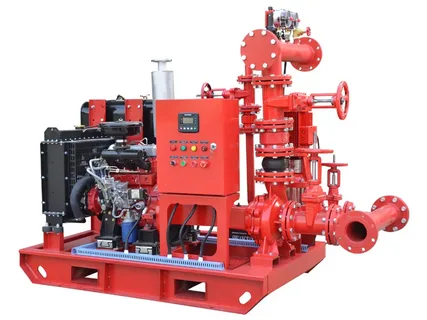
Fire pumps are essential components for your facility’s water based fire protection system. These pumps ensure that your fire sprinkler, alarm or hydrant systems will work in the event of an emergency. Fire pump installations are required to meet certain NFPA and FM requirements. Fire pumps can be driven by electric motors, diesel engines or even steam turbines. A diesel fire pump is a special type of pump driven by a diesel engine. It is commonly used in cases where the electrical supply to a property is unreliable or has insufficient capacity to provide the fire systems demand. A fire pump may also be utilized by clients who desire a secondary backup system in case of power failure or if the property is located in a seismic zone or high rise building.
Unlike an electric fire pump, a diesel fire pump requires a separate pump room with a specialized exhaust system. The exhaust system is designed to keep the back pressure on the diesel engine low and prevent heat transfer from the fire pump to the pump room and other facilities.
Like any diesel engine, a fire pump will require periodic service to prevent mechanical problems and maintain the life of the pump. This is much more so than an electric fire pump, as there are many more parts on a diesel fire pump that can go wrong. Neglecting the service of a fire pump could significantly shorten its lifespan, which is why it is important to keep up with the maintenance of your fire system.
A diesel fire pump should be tested weekly to make sure it will work properly in the event of an emergency. To perform a test, shut off the main discharge valve and turn the selector switch on the controller to the off position. Next, call the fire alarm company and inform them that you will be testing your fire pump. Close the manual isolation valves on both the suction and discharge lines of the fire pump to prevent any water hammer. Finally, open the fire suppression system manually and set all alarms to activate.
During this test, it is important to make note of any abnormal noises or smells coming from the fire pump. This will help to diagnose any issues before an emergency occurs. It is also important to ensure that the fire pump has a sufficient amount of fuel. Fuel tanks should be topped off periodically to avoid any shortages during an emergency. It is also important to ensure that all vent piping, oil drains and packing drip drains are properly connected, secured and insulated to prevent any freeze damage. Finally, all of the electrical connections on the fire pump should be properly inspected and cleaned before each test. These tips should be part of every facility’s pre-emergency plan to ensure that the fire pump will work properly when needed. diesel fire pump